Posts Tagged ‘Customised Manufacturing’
Outsourcing Your Product Assembly Line to China: 7 Tips for Success
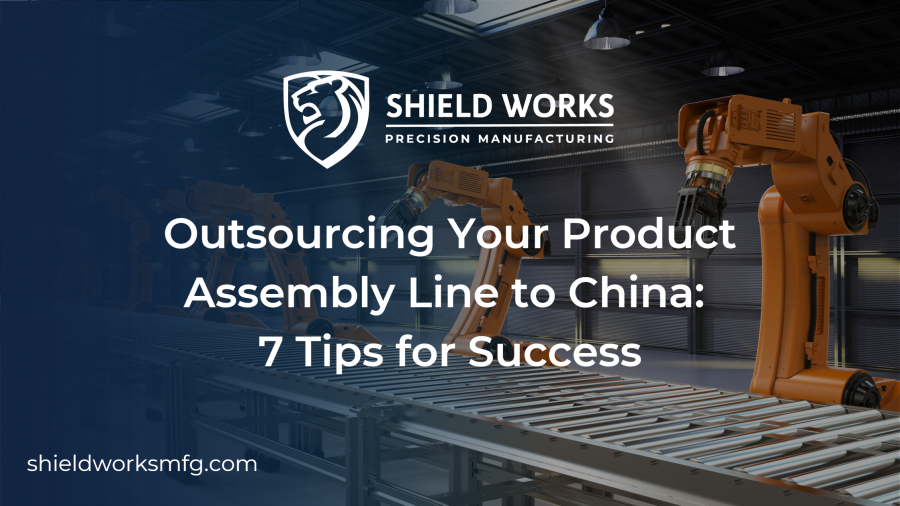
Outsourcing has become increasingly popular among businesses looking to reduce costs and increase efficiency. By outsourcing your product assembly line to China, you can take advantage of lower labor costs and access a highly skilled workforce.
However, outsourcing comes with its own set of challenges, especially when working with international suppliers. Here are seven tips to help you navigate the outsourcing process and achieve success:
Do Your Research
Before outsourcing your product assembly line to China, it’s essential to do your research. This means understanding the specific requirements of your product, including its dimensions, materials, and tolerances. Make sure you have a clear understanding of the manufacturing process and communicate this to your supplier.
When selecting a supplier, you should also consider their experience, reputation, and certifications. Look for a supplier with a proven track record of delivering high-quality products, and consider visiting their facilities to get a firsthand look at their operations.
Find the Right Company
When outsourcing to China, it’s important to find a supplier that can meet your specific needs. This includes lead times, shipping requirements, and final delivery requirements. You should also consider the supplier’s location and proximity to your target market. Working with a local supplier can help reduce shipping costs and lead times.
To find the right supplier, you can attend trade shows, search online directories, or work with a local sourcing agent. Don’t settle for the first offer – bargaining and negotiation are part of international trade, and you may be able to secure a better deal with a little negotiation.
Communicate Effectively
Effective communication is critical to successful outsourcing. Make sure you establish clear lines of communication with your supplier from the outset. This includes setting expectations for communication frequency, communication channels, and language proficiency.
When communicating with your supplier, be clear and detail-oriented. Provide detailed instructions and specifications for your products, including drawings, diagrams, and photographs. You should also be prepared to answer any questions your supplier may have and provide feedback promptly.
Have On-Site Quality Control
For new or complex products, having someone on-site to check quality control is essential. This can be a representative from your company, a third-party inspector, or a quality control specialist provided by your supplier. On-site quality control can help you identify any issues early in the manufacturing process and avoid costly mistakes.
For established and simple products, regular visits may not be necessary. However, you should still stay in touch with your supplier to ensure that the quality of your products remains consistent over time.
Prioritize Price and Quality
When outsourcing your product assembly line to China, it’s important to find a supplier who can balance price and quality. Don’t be tempted to choose a low-cost option that sacrifices quality or communication – this will only lead to higher costs in the long run.
It’s important to have a clear understanding of the costs involved in outsourcing, including shipping and customs fees. Make sure you negotiate favorable payment terms with your supplier to minimize your financial risk.
Set a Timeline
Setting a timeline for product assembly and shipment can help you manage your time better. Consider logistics and delivery when scheduling and be realistic about your expectations. Make sure you discuss timelines with your supplier to ensure that they can meet your deadlines.
When setting a timeline, it’s important to factor in any potential delays or issues that may arise. This will help you avoid unexpected delays and ensure that your products are delivered on time.
Implement Quality Control Systems
Implementing quality control systems at every stage of the manufacturing process is essential. This includes inspecting products at each stage to catch mistakes early and prevent defective products. A manufacturer with experience, like Shield Works, can help ensure quality control.
You should also have a system in place to track and manage any product defects or issues that arise during manufacturing. This can help you identify any recurring issues and work with your supplier to implement corrective actions.
By implementing quality control systems, you can ensure that your products meet your specifications and quality standards, and minimize the risk of costly product recalls or customer complaints.
Outsourcing your product assembly line to China can be a cost-effective solution for your business, but it’s important to be prepared for the challenges that come with it. By doing your research, finding the right supplier, communicating effectively, implementing quality control systems, and prioritizing price and quality, you can achieve successful outsourcing and grow your business.
If you’re considering outsourcing your product assembly line to China, contacting Shield Works can be a smart choice. With their extensive experience in helping western companies outsource their assembly line to China, Shield Works has developed their own in-house assembly facility and IP protection system to ensure the highest standards of quality control and intellectual property protection. Contact Shield Works today to learn how they can help you achieve successful outsourcing and grow your business.
Finding an IP Protective Manufacturing Partner in China: 5 Common Mistakes to Avoid
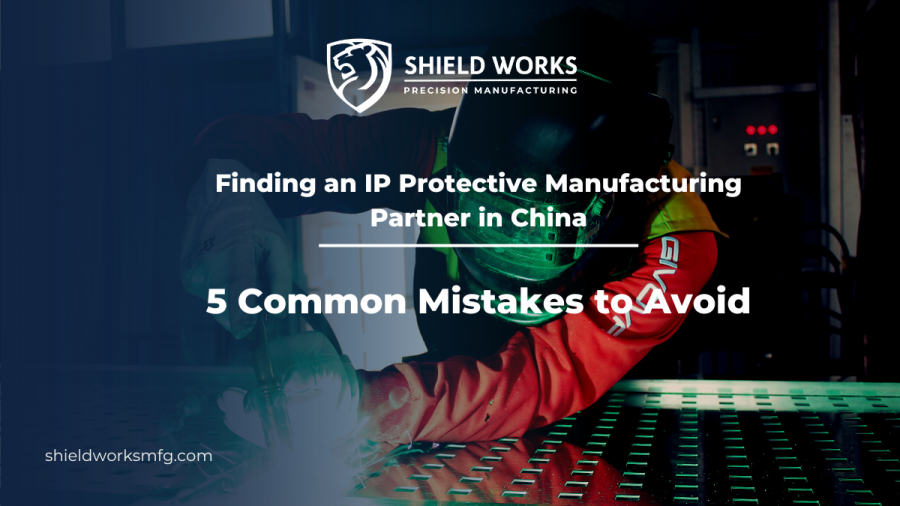
Outsourcing your production to China can offer considerable benefits, such as decreased production costs and manpower requirements.
However, many Western companies that don’t know how to protect their ideas and designs when searching for a manufacturing partner in China can risk compromising their quality and facing IP leakage or other unexpected consequences.
To help you make an informed decision and ensure a strong partnership that benefits both parties in the long term, we have put together this guide on the five most common mistakes to avoid when searching for an IP protective manufacturing partner in China. Read on to learn more!
1. Not Defining and Registering Your IP
Before choosing a manufacturing partner in China, it is essential to define and register intellectual property (IP) in your home country. Typically, intellectual property consists of different forms of assets, including trademarks, patents, and copyrights.
Trademarks
A trademark can be a word, phrase, symbol, design, or a combination of these elements that distinguish a specific item from the rest. For example, the Coca-Cola Company has registered its Coca-Cola® trademark in both standard character format and special form formats.
Patents
A patent is an exclusive right granted for an invention, which could be a design, process, improvement, or physical invention such as the new machine. Typically, there are three types of patents:
- Design patents
- Plant patents
- Utility patents
Copyrights
A copyright is a collection of rights that automatically vest to someone who creates an original work of authorship. The most common copyrights include:
- Literary works
- Musical works
- Dramatic works
- Pictorial, graphic, and sculptural works
- Architectural works
2. Not Knowing Your Rights Under Chinese Law
Having a good understanding of your rights and the legal protections available is an essential part of securing your intellectual property (IP) when moving your production to China. This is because registering your IP in your homeland won’t provide the same protection when you begin to produce in another country as the regulations of IP laws vary from nation to nation. In this case, you should register your IP in China and become knowledgeable of your IP rights according to Chinese laws and regulations.
Depending on the type of IP protection you need, it is important to know which laws apply to you and your product. For example, if you are looking for patent protection in China, you must register your patent with the Chinese Patent Office and make sure it complies with all applicable regulations.
For the best protection against potential IP infringement, you can consider employing a dependable legal service provider in China. Their knowledgeable attorneys, fluent in both Mandarin and English, will guide you through the entire process.
3. Not Conducting Proper Due diligence
Before making a commitment to any manufacturing company in China, don’t forget due diligence. When searching for an IP protective manufacturing partner in China, you should ask yourself the following questions:
- Are they capable of manufacturing my product?
- What are their past experiences with similar projects?
- Are their employees familiar with IP protection?
- Can they guarantee the security of my IP?
It’s also important to read reviews from previous customers. By doing so, you can find such information by posting questions on Quora.
Additionally, don’t forget to confirm that your chosen manufacturing partner has the right certifications and qualifications, as well as industry standard procedures in place to ensure your IP is adequately protected.
4. Not Having an Enforceable Contract
Before developing an IP protective agreement with a manufacturer in China, you should first identify and clearly communicate your IP expectations. Without a well-defined IP strategy, you are unable to effectively protect your assets when you enter into a manufacturing partnership in China.
After ensuring a potential supplier is able to satisfy your requirements, be sure to record every term in a formal, legally-binding agreement. An enforceable contract should specify all the rights, responsibilities, and obligations of both parties and be written in accordance with Chinese law in both Chinese and English to protect your IP rights. It should clearly lay out the procedures for IP protection and enforcement, as well as any disputes that may arise. This contract should also include the terms and conditions of any transfer of IP, including licensing, confidentiality, and non-disclosure agreements.
By having a comprehensive and enforceable contract in place, you can ensure that your IP is properly protected and secure.
5. Not Monitoring Your IP
The last and most common mistake that many Western companies make when moving their production projects to China is that they don’t constantly monitor their IP.
It is important to keep track of what happens to your intellectual property once it is in the hands of your manufacturing partner in China. This includes tracking where your products are manufactured, as well as ensuring that proper IP protection measures are in place to prevent any unauthorized use or theft.
It is important to also ensure that any changes made to the design of your products are reported back to you and approved by you before they are released for production. Without this level of monitoring, you may find that your IP is infringed upon without your knowledge and be unable to take action.
Partner with an Experienced Manufacturer in China
Even if you have a well-established strategy to safeguard your IP, you still need to be careful when selecting the right manufacturing company in China. This is a vital step that should not be made in haste, as many factors should be evaluated thoughtfully.
With Shield Works on board, you can have your production outsourced to China smoothly while keeping your intellectual property safe and secure, which can help you get the best results from your investment.
Founded in 2020, we are an offshoot of the British-owned and managed C2W Group located in the South China Greater Bay Area offering IP protective contract manufacturing services. We have a team of bilingual engineers on the ground to offer tailor-made services to meet your requirements. Get the ball rolling by contacting us today to go over the specifics and see how we can support you.
5 Risks When Outsourcing to an OEM Manufacturer in China

Outsourcing production to China is becoming a common business strategy for many Western businesses due to the quality of production and its potential for enhanced functionality at a lower investment. This is why even well-established corporations and startups alike are tapping into this lucrative approach, having already identified its myriad benefits.
It is not always the case that utilizing an outsourcing service yields successful and desirable outcomes. Since you are counting on a third-party company to execute essential assignments for you, you could end up with different results due to their capacities.
In this blog post, we’ll discuss 5 of the major risks of outsourcing manufacturing to China and how you can avoid them. With this knowledge, you can make sure you have the most competent manufacturer and a successful business venture.
1. Communication Barriers
One of the main risks of outsourcing manufacturing to China is communication barriers. This can be due to cultural and language differences, as well as a lack of technological infrastructure and understanding of how business is conducted in other countries.
To avoid this, it’s important to make sure there is clear communication between your business and the Chinese manufacturer you choose to work with. Make sure they understand your expectations and timeframes and that you have clear processes and documentation in place. It’s also helpful to have someone on your team who is familiar with Chinese culture and language so they can better communicate your needs. Finally, make sure you are regularly checking in on the status of the project and keeping track of key milestones. By taking these steps, you can ensure effective communication when outsourcing manufacturing to China.
2. Inexperienced Manufacturers
When outsourcing manufacturing to China, it is important to ensure that the manufacturer you choose has experience in the industry. Without sufficient experience, they may not be able to provide the quality and consistency you need to produce a successful product. Additionally, inexperienced manufacturers often lack the necessary machinery and personnel to handle complex projects.
What’s more, most Chinese manufacturers don’t use modern cloud-based project management systems, so it can be difficult to stay updated on progress, changes, and any issues that arise.
Therefore, it is important to research the potential manufacturers you are considering for your project before committing to a relationship. Make sure that they have the necessary resources, technology, and personnel for your specific manufacturing needs. You should also inquire about their previous work and ask for references from their previous clients. This will give you a better understanding of their capabilities and allow you to make an informed decision about whom to trust with your project.
3. Hidden Costs
When outsourcing manufacturing to China, it is essential to review all the costs involved to avoid any additional costs or hidden costs that you may not have initially budgeted for.
Typically, the additional costs may include high customs fees and import taxes when shipping finished products, added labor costs to ensure quality control, and additional materials needed due to substandard production.
When outsourcing manufacturing to China, it is critical to take the time to understand all the associated costs that come with manufacturing in the country. Carefully review any quotations and contracts prior to signing, as they may contain clauses or restrictions that can increase costs without your knowledge. Additionally, seek out experienced partners who have an understanding of China’s business environment and culture, as this can help you avoid costly mistakes.
4. Quality Assurance Problems
Another risk of outsourcing manufacturing to China is the potential for poor product quality. Manufacturing in China requires companies to monitor the production process in order to ensure that the finished goods meet quality standards. To mitigate this risk, you must take proactive steps to ensure that the manufacturers they are working with have the necessary experience and resources to produce quality products.
To do this, companies should establish a quality assurance plan that outlines how the process should be monitored and documented. Companies should also require all manufacturers to sign a contract that clearly states the expectations for product quality and penalties for failing to meet them. Furthermore, companies should consider conducting random quality control inspections throughout the production process to identify any problems before they become costly. Finally, companies should consider investing in third-party inspections to verify the final product meets their requirements before shipment.
5. Intellectual Property Issues
When outsourcing manufacturing to China, companies must be aware of the risks of Intellectual Property (IP) theft. With an increasing number of Chinese manufacturers offering services to global businesses, it can be difficult to protect IP. Chinese manufacturers are often willing to reverse engineer designs or take advantage of a company’s Intellectual Property. This can lead to stolen designs, copied products, and damaged reputations for companies relying on manufacturing in China.
In order to prevent IP theft when outsourcing manufacturing, companies should establish strong agreements with their manufacturer outlining the details of the project and outlining any expectations around IP protection. It is also important to have an international attorney review the contract prior to signing. Lastly, companies should only work with manufacturers they trust and be sure to thoroughly vet the manufacturer before signing any agreement. Taking these measures can help protect companies from IP theft when outsourcing manufacturing to China.
Work With a Professional OEM Company in China
If you are looking to outsource your manufacturing needs to China, then it is essential to work with a professional OEM company like us Shield Works.
We are a British-owned and managed company that specializes in making products according to the highest industry standards and offers a variety of services such as product design, engineering, and fabrication services in a wide variety of fields. Our rigorous approach guarantees the highest quality and consistent service from order placement to delivery. Contact us today for further information.
A Beginner’s Guide to Manufacturing Service Agreements
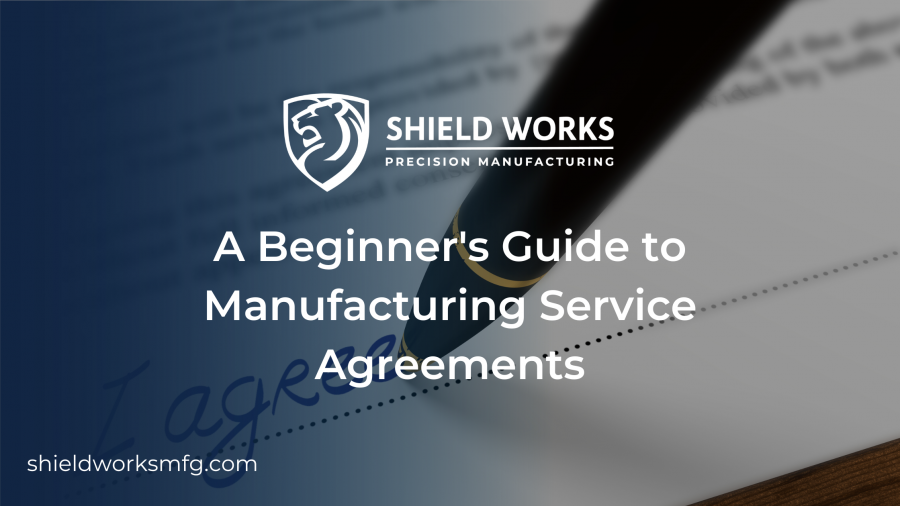
Manufacturing is a critical component of many businesses, but not all companies have the resources or expertise to handle the production process in-house. That’s where outsourcing comes in, and a crucial tool for outsourcing manufacturing is a Manufacturing Service Agreement (MSA). In this beginner’s guide, we’ll take a closer look at what MSAs are, why they’re important, and what you need to know to get started.
What is a Manufacturing Service Agreement?
A Manufacturing Service Agreement is a contract between two parties – the manufacturer and the customer – that outlines the terms and conditions of the manufacturing process. The agreement covers everything from the type of product to be manufactured to the cost, timeline, and quality standards. Essentially, an MSA defines the relationship between the two parties and sets the expectations for the manufacturing process.
Why is a Manufacturing Service Agreement Important?
An MSA is important because it ensures that both parties have a clear understanding of their obligations and responsibilities. This clarity helps to minimize misunderstandings and disputes, which can lead to costly delays and rework. Additionally, an MSA protects the customer’s intellectual property and ensures that the manufacturer is producing the product to the customer’s specifications.
Another important aspect of an MSA is that it outlines the process for resolving disputes. In the event of a disagreement, having a well-defined process in place can help to minimize the impact on the manufacturing timeline and reduce the risk of costly legal battles.
Key Components of a Manufacturing Service Agreement
There are several key components that are typically included in an MSA. These include:
Product specifications
This section outlines the product design, materials, and manufacturing process.
Timeline
The timeline section specifies the expected start and completion dates for the manufacturing process.
Cost
The cost section outlines the payment terms, including the total cost, payment schedule, and any additional fees.
Quality Standards
This section outlines the quality standards that the manufacturer is expected to meet, such as industry standards or customer-specific requirements.
Intellectual Property
This section outlines the ownership of the product and any related intellectual property, such as patents or trademarks.
Confidentiality
The confidentiality section outlines the obligations of both parties to maintain the confidentiality of the manufacturing process and any related information.
Liability and indemnification
This section outlines the responsibilities of both parties in the event of any losses or damages.
Dispute Resolution
The dispute resolution section outlines the process for resolving any disputes that may arise during the manufacturing process.
Getting Started with a Manufacturing Service Agreement
Now that you have a better understanding of what a Manufacturing Service Agreement is and why it’s important, it’s time to get started. The first step is to identify your needs and the type of product you want to have manufactured. This will help you to determine the type of manufacturer you need to work with and the specifications that must be included in the MSA.
Once you have identified your needs, it’s time to start negotiating the terms of the MSA with the manufacturer. This is a critical step, so it’s important to work with an attorney who specializes in MSAs to ensure that you are getting the best deal possible.
How to Negotiate a MSA That Benefits Your Business
When it comes to a complex legal document that can have a significant impact on your business, you always want to ensure that you are getting the best deal possible. That’s why it’s important to know how to negotiate a good MSA that benefits your business. Here are some tips to help you get started:
Do Your Homework
Before you start negotiating the terms of the MSA, it’s important to do your homework. Research the manufacturer and understand their capabilities and limitations. This will help you to determine the type of agreement that you need and the terms that must be included in the MSA.
Work with an Attorney
An attorney who specializes in MSAs can help you to understand the legal implications of the agreement and ensure that you are getting the best deal possible. They can also help you to navigate any potential obstacles and negotiate the terms of the agreement effectively.
Outline Your Needs
Clearly outline your needs and the type of product you want to have manufactured. This will help you to determine the type of manufacturer you need to work with and the specifications that must be included in the MSA.
Be Realistic
When negotiating the terms of the MSA, it’s important to be realistic. Make sure that the terms are achievable and that you have the resources and expertise to meet the obligations outlined in the agreement.
Focus on the Big Picture
While it’s important to pay attention to the details, it’s also important to focus on the big picture. Make sure that the MSA meets your overall business goals and supports your long-term strategy.
Be Flexible
Be willing to compromise on certain terms in order to reach an agreement that benefits both parties. Remember that the goal is to create a mutually beneficial relationship that will last for the long-term.
Don’t Rush the Process
Negotiating an MSA can take time, so it’s important not to rush the process. Take the time to review the agreement carefully and ensure that you are comfortable with the terms before you sign.
By clearly defining the terms and conditions of the manufacturing process, an MSA helps to minimize misunderstandings, protect intellectual property, and ensure that the manufacturing process meets the customer’s expectations. Whether you’re a seasoned professional or just starting out, understanding MSAs is an important step in successfully outsourcing your manufacturing needs.
As a reputable manufacturing company with positive references in the industry, Shield Works always ensures our customers’ rights are well respected and honored. To know more about us, please feel free to contact us!
Unleashing the Secrets of a Seamless Product Assembly Process

Product assembly is an essential part of the manufacturing process and is critical to the success of any product. Whether you are a small start-up or a large corporation, a seamless product assembly process can greatly impact your bottom line and help you stay ahead of the competition.
In this article, we will explore the secrets of a seamless product assembly process and provide you with the tools and knowledge you need to streamline your product assembly process for maximum efficiency, cost savings, and quality.
Understanding the Stages of the Product Assembly Process
The product assembly process typically consists of several stages, each of which plays a critical role in ensuring a high-quality final product. These stages can include:
Design & Prototyping
The first stage of the product assembly process is the design and prototyping stage. During this stage, the product is designed and a working prototype is created. This stage is critical because it allows you to test the product and make any necessary changes before it goes into full production.
Raw Materials Procurement
The next stage is the procurement of raw materials. This stage involves sourcing the materials that will be used to create the final product. It is important to choose the right materials to ensure that the product is durable, reliable, and meets the required specifications.
Parts Fabrication
Once the raw materials have been procured, the next stage is the fabrication of the parts. This stage involves cutting, shaping, and forming the materials into the necessary parts for the product.
Component Assembly
The component assembly stage involves putting the parts together to create the subassemblies that make up the final product. This stage requires precision and attention to detail to ensure that the subassemblies fit together correctly and are functional.
Final Assembly
The final stage of the product assembly process is the final assembly stage. During this stage, the subassemblies are put together to create the final product. This stage is critical because it is the final opportunity to make any necessary adjustments or improvements to the product before it is packaged and shipped to customers.
Streamlining the Product Assembly Process
To streamline the product assembly process, there are several key principles that you can follow. These include:
Automation
Automating certain parts of the product assembly process can greatly improve efficiency and reduce the risk of errors. Automated systems can be programmed to perform specific tasks, such as placing components in the correct position, checking for proper alignment, and monitoring the quality of the product.
Standardization
Standardizing the product assembly process can help to ensure consistency and improve efficiency. This can be achieved by using standardized procedures, tools, and equipment to ensure that each step of the process is performed the same way every time.
Continuous Improvement
Continuous improvement is key to a seamless product assembly process. By constantly evaluating the process and making improvements, you can reduce waste, increase efficiency, and improve the quality of the final product.
Lean Manufacturing
Lean manufacturing is a philosophy that emphasizes the elimination of waste and the optimization of resources. By incorporating lean principles into the product assembly process, you can reduce waste, improve efficiency, and increase profitability.
Tools & Technologies for a Seamless Product Assembly Process
There are several tools and technologies that can help you streamline the product assembly process and improve the quality of the final product. These include:
Computer-Aided Design (CAD) Software
CAD software can be used to design the product and create a virtual prototype. This allows you to make changes and test the product before it goes into full production.
3D printing
3D printing can be used to create prototypes and even final products in some cases. This technology has revolutionized product assembly by allowing manufacturers to quickly and easily create prototypes, test and refine designs, and even create final products with greater precision and accuracy.
Automated Inspection Systems
Automated inspection systems can be used to check the quality of products during the assembly process. These systems use cameras and sensors to inspect the product and identify any defects or deviations from the specified requirements. This helps to ensure that the final product meets the required standards and reduces the risk of product defects.
Industrial Robots
Industrial robots can be used to automate certain tasks in the product assembly process. These robots can be programmed to perform tasks such as placing components in the correct position, checking for proper alignment, and monitoring the quality of the product. By using robots in the product assembly process, you can reduce the risk of errors and improve efficiency.
Integrated Software Systems
Integrated software systems can be used to manage the product assembly process from start to finish. These systems can be used to track the progress of each step of the process, monitor production schedules, and control inventory levels. By using integrated software systems, you can improve the visibility of the product assembly process and ensure that everything runs smoothly.
A seamless product assembly process is critical to the success of any product. By understanding the stages of the process, following key principles such as automation, standardization, and continuous improvement, and utilizing tools and technologies such as CAD software, 3D printing, automated inspection systems, industrial robots, and integrated software systems, you can streamline your product assembly process and improve the quality of the final product. With these secrets, you can unlock the potential for greater efficiency, cost savings, and customer satisfaction.
Shield Works is a assembly facility with 18 years of experience and IP-protected production units. We can save you the hassles of assembling your product all the way from the get-go. Contact us today!
Product Assembly Line Design: How to Improve Efficiency and Reduce Costs

Product assembly lines are the backbone of modern manufacturing. They are used to produce goods efficiently and at a low cost. However, designing an efficient and cost-effective assembly line can be a challenging task. In this blog post, we will discuss some key strategies for designing a product assembly line that improves efficiency and reduces costs.
Understand Your Product
First and foremost, it is essential to understand the product being assembled. This includes understanding the product’s dimensions, weight, and required assembly steps. This information will help determine the layout of the assembly line and the equipment needed.
For example, if the product is large and heavy, a conveyor belt system may be required, whereas a smaller product may only require a workbench.
Understanding the product also helps in determining the number of stations required on the assembly line, the type of equipment needed and the number of employees required to operate the assembly line.
Moreover, it’s important to consider the product’s life cycle and production volume, to make sure that the assembly line is designed to meet current and future needs.
Know the Flow
Another important aspect to consider is the flow of the assembly line. The goal is to create a smooth and efficient flow of materials, components, and finished products.
This can be achieved by using techniques such as lean manufacturing, which focuses on eliminating waste and maximizing efficiency. Lean manufacturing focuses on the elimination of waste, which includes anything that does not add value to the product. This includes overproduction, waiting, unnecessary transportation, overprocessing, excess inventory, unnecessary motion, and defects.
By eliminating waste, manufacturers can improve efficiency and reduce costs. Furthermore, the flow of the assembly line should be designed in a way that minimizes the distance and time that materials, components, and finished products need to travel. This can be achieved by using techniques such as U-shaped assembly lines, cellular manufacturing, and continuous flow manufacturing.
Automate Certain Tasks
One way to reduce costs is by automating certain tasks on the assembly line. Automation can improve efficiency and reduce the need for manual labor, which can be costly.
However, it is important to strike a balance between automation and manual labor, as some tasks may be better suited for manual labor. For example, tasks that require a high degree of precision and accuracy may be better suited for automation, whereas tasks that require dexterity and flexibility may be better suited for manual labor.
Additionally, automation can help with reducing the variability of the process, which can lead to improved quality and consistency of the product.
Use Robotics
In addition to automation, it’s important to consider the use of robotics on the assembly line. Robotics can improve the speed and accuracy of certain tasks, but it’s important to weigh the costs of implementation and maintenance. Robotics can be an expensive investment, and it’s important to ensure that the benefits outweigh the costs.
Robotics can also be integrated with automation, which can lead to significant improvements in efficiency and cost reduction. Moreover, the use of robotics in the assembly line can help with reducing the need for manual labor, which can improve the safety of the assembly line.
Create a Maintenance Program
It’s also important to implement a maintenance program for the assembly line to ensure that it is running at peak performance. Regular maintenance can help prevent breakdowns, which can be costly in terms of both time and money.
A good maintenance program should include regular inspections, preventive maintenance, and predictive maintenance. Regular inspections can identify potential problems before they occur, preventive maintenance can prevent problems from occurring, and predictive maintenance can predict when equipment will fail, so that maintenance can be performed before a failure occurs.
Furthermore, it’s important to consider the maintenance of the software and the computer systems that are used to control the assembly line.
Ensure Safety
Lastly, it’s crucial to consider the safety of the assembly line. This includes providing proper training for employees, implementing safety protocols and regulations, and regularly inspecting the assembly line for potential hazards. A safe assembly line not only protects the employees from injury, but it also protects the equipment from damage and reduces the risk of liability.
Proper training for employees is essential for ensuring the safety of the assembly line. This includes training on the proper use of equipment, as well as training on safety protocols and regulations. It’s important to provide ongoing training, as new equipment and procedures are introduced. Additionally, it’s important to provide training in emergency procedures, in case of a breakdown or accident.
Designing an efficient and cost-effective product assembly line requires a thorough understanding of the product, the flow of the assembly line, automation, robotics, maintenance, safety, inventory management, digital design, and data analytics. By implementing these strategies, manufacturers can improve efficiency, reduce costs, and ensure that the assembly line is running smoothly. It’s important to remember that the design of the assembly line is not a one-time process and it should be reviewed and updated regularly, to keep up with the changing market conditions and technology advancements.
Working with an experienced manufacturer already with a system in place can help you significantly in securing all the above recommendations. Shield Works is one that you can count on with 17 years of experience and our self-owned facility. Contact us now!
Top 10 Tips for Finding a Reliable Contract Manufacturer in China
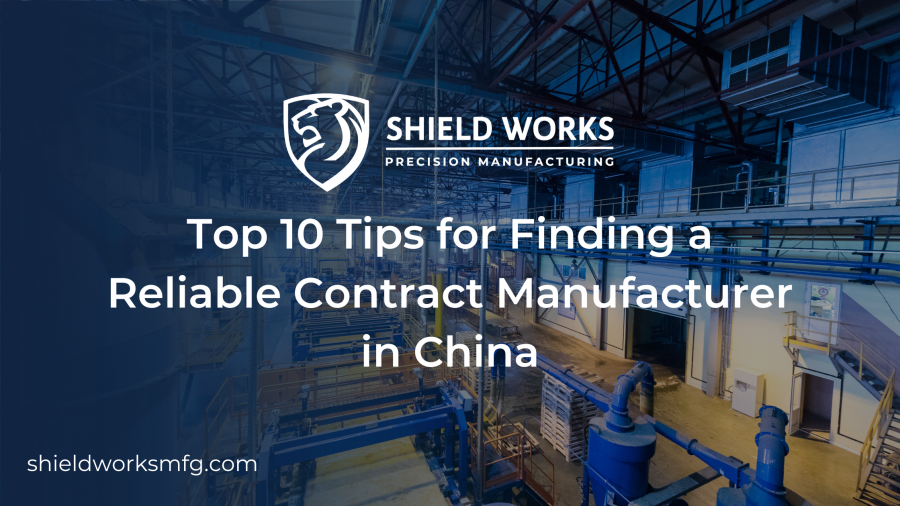
China has long been known as the factory of the world, and for good reason. With its vast pool of skilled labor and competitive pricing, it’s no wonder that so many businesses turn to China when looking for a contract manufacturer. However, as with any business endeavor, it’s important to tread carefully and do your due diligence when searching for a contract manufacturer in China.
In this blog post, we’ll be sharing the top 10 tips to help you find a reliable contract manufacturer in China. By following these tips, you’ll be able to navigate the Chinese manufacturing landscape with confidence and find a quality partner to help bring your products to market.
Tip #1: Do Your Research
Before you even begin your search for a contract manufacturer in China, it’s important to do your research. This means learning about the different regions of China, the different industries, and the types of products that are manufactured in each area. This will help you narrow down your search and make it easier to find a contract manufacturer that specializes in the type of products you need.
Tip #2: Use Online Resources.
The internet is a treasure trove of information when it comes to finding a contract manufacturer in China. There are a number of websites and platforms that can help you connect with manufacturers, such as Alibaba and Google. However, it’s important to remember that not all manufacturers listed on these sites are legitimate, so be sure to do your due diligence and vet any potential partners carefully.
Tip #3: Visit Factories in Person
One of the best ways to ensure that a contract manufacturer is legitimate and capable of delivering the quality of products you need is to visit the factory in person. This will allow you to see the facilities, meet the staff, and get a sense of the manufacturing process firsthand. It’s also a good opportunity to discuss your requirements and ensure that the factory has the capabilities to produce your products. Now that China is all reopened, you can travel whenever you can!
Tip #4: Check for Certifications & Standards
When looking for a contract manufacturer in China, it’s important to check for certifications and standards. This can include ISO certifications for quality management and environmental management, as well as certifications for specific industries such as toy safety or medical device regulations. Having these certifications can be an indication of a manufacturer’s commitment to quality and can give you peace of mind when it comes to the safety and compliance of your products.
Tip #5: Consider Language & Cultural Barriers
China is a vast country with many different regions and dialects, and this can lead to language and cultural barriers. When selecting a contract manufacturer, it’s important to consider these barriers and make sure that there is good communication between your team and the manufacturer’s team. This can include hiring a translator or hiring a sourcing agent who is familiar with the Chinese market and culture.
Tip #6: Get References & Check Them
When looking for a contract manufacturer in China, it’s important to get references from other companies that have worked with the manufacturer. This can give you an idea of the manufacturer’s reliability, quality of products, and ability to meet deadlines. Be sure to check these references carefully and ask for specific examples of how the manufacturer has performed in the past.
Tip #7: Look for a Long-Term Partnership
A contract manufacturer is not just a vendor, it’s a partner in your business. When looking for a contract manufacturer in China, it’s important to consider the long-term potential of the partnership. This includes things like the manufacturer’s ability to scale production as your business grows and the manufacturer’s willingness to invest in new technologies and equipment to improve the quality of your products. A long-term partnership can lead to cost savings and improved efficiency in the long run.
Tip #8: Consider the Logistics & Shipping
When working with a contract manufacturer in China, logistics and shipping can be a major concern. Make sure to discuss shipping options with the manufacturer and consider things like lead time, shipping costs, and customs clearance. It’s also important to consider the manufacturer’s location in relation to your market, as this can affect shipping times and costs.
Tip #9: Protect Your Intellectual Property
Intellectual property (IP) is a major concern when working with a contract manufacturer in China. Make sure to take steps to protect your IP, such as signing non-disclosure agreements (NDAs) and registering your trademarks and patents in China. It’s also important to be vigilant about monitoring for IP infringement and taking action if necessary.
Tip #10: Be Prepared for the Unexpected
Despite your best efforts, things can still go wrong when working with a contract manufacturer in China. Be prepared for the unexpected by having contingency plans in place and being open to problem-solving. This can include having backup manufacturers or sourcing alternative materials if necessary.
Finding a reliable contract manufacturer in China is not always easy, but by following these tips, you can increase your chances of success. Remember to do your research, visit factories in person, and look for a long-term partnership. By investing the time and effort to find the right contract manufacturer, you can ensure that your products are of the highest quality and that your business is on track for success.
Shield Works is one that checks all the aforementioned boxes, with 17 years of experience and self-owned facility that guarantees the whole process will be done in-house and on your watch. Contact us today!
Contract Manufacturing in China: Top 5 Pros and Cons for Western Companies
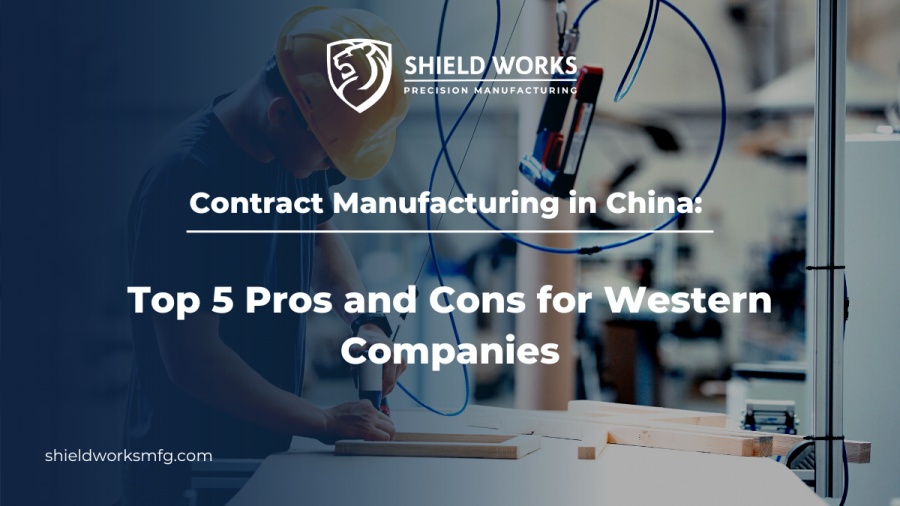
There is no doubt that making products in China can be an excellent choice for western companies to save more money and increase margins.
Due to the low costs of labor and natural resources, production costs are relatively low in China when it’s compared to other western countries.
But wait, do you think that everything is just perfect in China? Keep in mind that one cannot simply judge something based solely on the good points without knowing how many bad points exist as well.
In this article, we will explore the top five advantages and disadvantages of manufacturing in China so that you can evaluate whether it’s suitable to outsource your production to China or not. Let’s get started.
Advantage: Lower Operating Costs
Manufacturing costs often differ depending on many factors, including the availability of labor, raw materials quality, production techniques, and shipping routes. With cheap labor and abundant natural resources available in China, manufacturing companies can make products at a cheaper rate than Western companies.
As a result, many American or European-based businesses are willing to move their production to China due to this competitive cost advantage compared to their home countries.
Advantage: Supportive Policies
The Chinese government is always working to provide the most favorable cooperation conditions for foreign businesses. A good example is the ongoing “Made in China 2025” initiative, which aims to upgrade the country’s manufacturing sector.
Furthermore, the government offers lucrative financial benefits to create an attractive environment for Western-based businesses. These include reductions of taxes on profits made from patents and copyrights as well as subsidies for R&D projects.
Advantage: Well Developed Infrastructure
In the past decade, China has made significant progress in developing and improving its infrastructure around the whole country, and there are many projects still in construction.
Now, China has a comprehensive network of roads, railways, bridges, airports, and seaports that can support all kinds of manufacturing and even heavy industries like steel or aluminum production. There are many reasons why foreign companies should consider outsourcing their production to Chinese contract manufacturers but one important thing to note is how the country excels at quick delivery times due to the state-of-the-art transportation system it now has in place.
Advantage: High Flexibility
Production of goods within the Chinese manufacturing industry has undergone dramatic changes throughout the past two decades, moving away from a one-size-fits-all mentality towards a more customized approach. From raw material purchasing and fabrication to assembly as well as delivery, manufacturing in China is becoming more and more flexible than ever before.
The high flexibility of making products in China makes it possible for different companies around the world to have opportunities to produce goods that are made specifically for their target market.
These would be ideal circumstances for any company looking to introduce a new product. Companies can work on designing, prototyping some models, and then modifying the products until they are perfect enough to be released into the marketplace.
Advantage: Professional and Friendly Cooperation
Although there may be a few scammers among China’s manufacturers, for the most part they are highly trained professionals who have years of experience under their belt. They are always more than willing to accept your new ideas and take it upon themselves to make sure you will be completely satisfied with the end product, going out of their way to make sure that everything is done right.
This is because now more and more manufacturing companies understand the significance of having a good reputation in the field and they feel no need to cheat on others. Instead, these businesses want to create long-term relationships with their clients.
Disadvantage: Different Standards
The first disadvantage that Western companies are afraid of if that the standards in China are very different than what they’re accustomed to. Whereas an overseas brand might have certain safety requirements, testing procedures, or regulatory guidelines, these things might not be as prevalent (or enforced) in China. This can lead to problems with the final product quality if you don’t confirm carefully before cooperating with a contract manufacturing company.
If you’re going to outsource production to China, make sure you check for any laws or policies that would prohibit your business from doing what they need. Furthermore, you should stay up to date with any relevant regulations pertaining specifically to your industry so that there aren’t any legal hurdles holding back progress for your project.
Disadvantage: Quality Control Issues
Western companies often experience quality control problems when outsourcing the production of their items to a random factory in China. Problems are common with defective or damaged products and there is no easy way for these companies to rework or repair them, which leads to major losses.
Thus, as many foreign buyers are starting to adopt more stringent quality standards and techniques and work with more professional suppliers, this problem is gradually being resolved. Also, it’s now much easier for an overseas brand to rely on a third-party quality control company to conduct full inspections before and during the production process, especially if they’re paying upfront.
Disadvantage: More Controllable
Production scheduling is a necessity for all manufacturing operations. Foreign importers often find that it’s more effective and controllable to keep production close to home so long as they can maintain high levels of product quality and production timeline.
Producing in China can be challenging because of how fast things change. A perfect example of a sudden change could be when an essential machine stops working without warning, which can cause the whole production schedule to fall apart. So, it’s always important to make sure you’re prepared for anything before starting something new.
Disadvantage: Intellectual Property Theft
Protecting your intellectual property is a major concern when considering moving your manufacturing project to China. The country used to have notoriously lax copyright laws and it is not uncommon for Western companies to have their designs stolen or copied by their manufacturing partners or in-house employees.
If you are serious about protecting your IP and the brands that represent it, try to work with someone that can offer IP-right protective agreements before cooperation.
Disadvantage: Lack of Transparency
Many foreign-owned brands are unused to the lack of transparency in China’s manufacturing process. They prefer to meet with engineers in person to adjust their production methods or monitor quality.
Furthermore, with lower wages in China and government subsidies for manufacturing facilities, many export-oriented service providers may make an additional markup if you don’t negotiate price quotes with them. Especially when you don’t speak Mandarin or Cantonese, you could run the risk of paying more than what was originally quoted.
Is Outsourcing Production to China Right for Your Business?
When evaluating whether to move your production to China or not, you should review what will work best for your business in terms of costs, product quality, and quantity. There are advantages and disadvantages to each side, but whatever option your company decides on, it must remain committed to maintaining high levels of quality control because this level of commitment will be shown to yield higher profits in the end.
If you are ready to work with contract manufacturer in China, then look no further than Shield Works.
As a British-owned and operated company specializing in contract manufacturing and product assembly, we offer reliability and consistency while adhering to the highest standards of workmanship. Reaching out today so we can tell you how we can help with your project!
Working With a Product Assembly Company in China: 10 Things to Consider
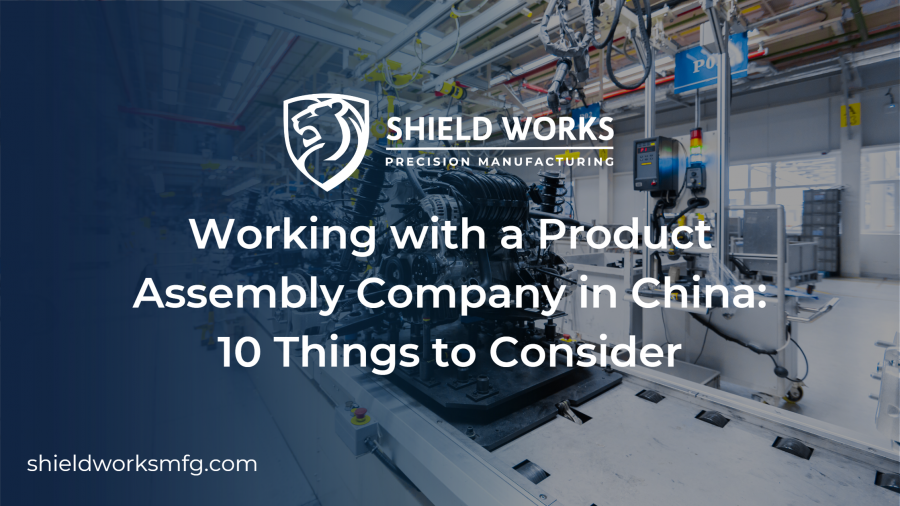
Working with a product assembly company in China can be a cost-effective solution for manufacturing products, but it is important to pay attention to a number of factors to ensure a successful outcome.
From ensuring quality control and understanding lead times to protecting intellectual property and navigating cultural differences, these considerations will help to ensure a smooth and successful manufacturing process. By carefully considering these 10 points, you can increase your chances of success when working with a product assembly company in China.
Quality control
Ensuring that the finished products produced by the assembly company meet your standards is crucial. Make sure to discuss the company’s quality control processes and procedures, and consider visiting their facility to observe them firsthand now that China has reopened its borders.
This will help to ensure that the products produced meet your specifications and requirements. It is also a good idea to set clear quality standards and establish a process for addressing any issues that may arise.
Lead times
It is important to be aware of the lead times for production and delivery, as well as any potential delays that may arise due to factors such as holidays or unexpected events.
Make sure to build in sufficient time for production and delivery in your overall project timeline to avoid any delays or disruptions. It is also a good idea to plan for contingencies in case of unexpected delays.
Communication
Good communication is key to a successful working relationship. Make sure to establish clear lines of communication with the assembly company, including a designated point of contact, and discuss any issues or concerns as soon as they arise.
This will help to prevent misunderstandings and ensure that any problems are addressed promptly. It is also a good idea to have regular check-ins with the company to stay up-to-date on the progress of your project.
Costs
Understanding all of the costs associated with working with the assembly company is important. This includes material costs, labor costs, and any additional fees.
Negotiate a fair price and consider asking for a written quote to ensure that there are no misunderstandings. It is also a good idea to budget for any potential additional costs that may arise during the production process.
Intellectual property
Protecting your intellectual property is crucial when working with a product assembly company in China. Make sure that the company has agreements in place to safeguard your intellectual property, such as non-disclosure agreements and intellectual property licensing agreements.
This will help to prevent unauthorized use or disclosure of your intellectual property. It is also a good idea to consider registering your intellectual property in China to provide additional protection.
Legal issues
There may be a few issues to consider when working with a company in China, such as differences in business practices or regulations.
It is a good idea to have some legal aid to help navigate any legal issues that may come up and protect your interests. This may include reviewing contracts and agreements, and providing guidance on regulatory matters.
Cultural differences
It is important to be mindful of cultural differences when working with a product assembly company in China. Try to build a good working relationship with the company by showing respect for their culture and practices.
This may involve adapting to different business customs and communication styles. It is also a good idea to educate yourself on Chinese culture and customs to better understand and appreciate the perspective of the assembly company.
Sustainability
The environmental impact of working with a product assembly company in China is something to consider. Look for a company that is working to reduce their carbon footprint and minimize their environmental impact.
This can help to reduce your own environmental impact and may be important to your customers. It is also a good idea to discuss sustainability practices.
Flexibility
Being open to working with the assembly company to find solutions to any challenges that may arise can be helpful.
This may involve adjusting your product design or production timeline to accommodate the company’s capabilities or constraints.
Payment terms
Clearly defining payment terms and ensuring that they are fair and reasonable for both parties is important.
Consider using a letter of credit or escrow account to protect yourself in case of any disputes. This can provide security and help to ensure that you are paid on time.
By paying attention to these 10 factors, you can increase your chances of success when working with a product assembly company in China. From establishing clear lines of communication to protecting your intellectual property, these considerations will help to ensure a smooth and successful manufacturing process.
But a great assembly company there will make the process even easier and smooth. One with ample experience, their own facility and legal partnerships, like Shield Works, which can help you secure quality components and parts, ensure in-house operation and have your IP in good hands. Contact us today!
5 Hidden Perks of OEM Manufacturing in China You Aren’t Told of
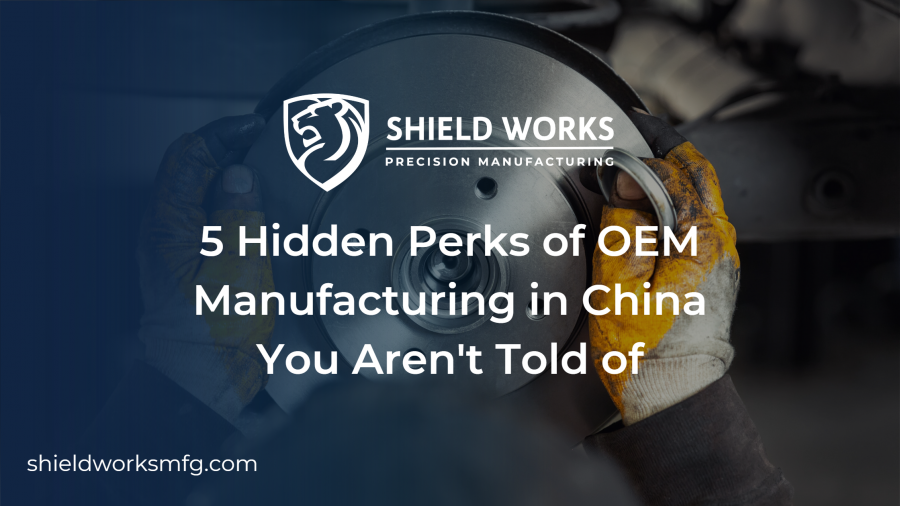
OEM manufacturing in China can be a great option for businesses looking to expand their reach in the global market. It offers many advantages, including cost savings, a larger customer base, and access to more resources. However, there are several hidden perks that many people are unaware of when it comes to OEM manufacturing in China. In this blog post, we’ll share five of these lesser-known benefits that you may not have known about before. So keep reading to learn about the hidden perks of OEM manufacturing in China that you aren’t told of!
Cost-Effectiveness
OEM manufacturing in China has become increasingly popular over the last few decades due to its cost-effectiveness. China offers lower production costs, wages, and overhead expenses compared to other countries, allowing businesses to remain competitive and maximize their profits.
In addition to the general cost savings associated with outsourcing production to China, there are other financial benefits.
Companies are able to reduce the cost of shipping by having their components made close to the source of raw materials. Additionally, due to the scale of production available in China, businesses can benefit from bulk discounts and better pricing on raw materials.
Finally, by keeping production in China, businesses can reduce the need for long-term investments in expensive equipment and staff. This allows them to focus on the core aspects of their business and invest their resources more effectively.
A Large Pool of Skilled Workers
When it comes to finding reliable workers for your OEM manufacturing in China, there is an abundance of skilled and experienced labor available. There are over 800 million people in the labor force in China, making it one of the largest markets for hiring workers.
Moreover, the Chinese workforce is known to be highly dedicated and driven, ensuring that your manufacturing projects will be completed on time and to the highest standards.
Not only does China have a large pool of skilled workers but their wages are also significantly lower than other developed countries. This makes it a great choice for companies looking to cut costs and increase their profit margins.
Furthermore, many Chinese factories are willing to negotiate prices and terms, meaning that you can get a good deal on manufacturing services when working with them.
Overall, China’s large pool of skilled workers makes it an attractive choice for OEM manufacturing. With so many experienced laborers available and relatively low wages, you can save money while still getting high-quality results.
Efficient Lead Times
One of the biggest hidden advantages of OEM manufacturing in China is the efficient lead times. OEM manufacturers have established supply chains that can help to speed up production time, helping you to get your products to market faster.
Additionally, Chinese OEM manufacturers have been able to establish extensive networks of suppliers and raw materials to reduce the time it takes to get your products ready for sale. This can save your business both time and money.
Chinese manufacturers are also well-versed in international logistics and can often provide competitive shipping rates. By utilizing these services, you can reduce the cost of shipping and have your products delivered to customers faster. This can be extremely beneficial for businesses that rely on quick turnaround times.
Furthermore, OEM manufacturers in China are also very good at ensuring orders are filled in a timely manner. Many Chinese OEM manufacturers have established processes and systems to ensure orders are fulfilled as quickly and efficiently as possible. This can help to reduce the stress of managing orders and ensure that your customers receive their products when they need them.
Quality Control
When it comes to OEM manufacturing in China, one of the most important aspects is quality control. You need to make sure that all components are created with precision and accuracy, and that the finished product is of the highest quality possible.
With OEM manufacturers in China, you can rest assured that quality control processes are strictly followed and enforced.
It is required that all manufacturing processes adhere to the relevant quality standards and regulations. In addition, many Chinese manufacturers are also required to have their products tested by an independent 3rd-party certification agency before they can be sold.
This helps to ensure that all products meet the highest levels of quality and safety requirements.
Furthermore, OEM manufacturers in China use advanced technology such as Computer Aided Design (CAD) and Computer Aided Manufacturing (CAM) to ensure the production process is precise and accurate. This allows them to produce complex components with a high level of accuracy and consistency.
Finally, experienced technicians monitor the production process on a regular basis to ensure quality is maintained throughout the entire manufacturing process. This ensures that any issues are identified and rectified quickly, thus ensuring that the finished product is of a high quality.
Technology and Innovation
The one thing often overlooked is the country’s commitment to developing and implementing cutting-edge technology and innovation.
From using the latest equipment and advanced machinery to embracing new technologies, OEM manufacturers in China are leading the way in modern manufacturing solutions. They offer efficient processes, such as AI-powered solutions and robotics, that can drastically reduce production costs and time-to-market.
In addition, Chinese manufacturers have also invested heavily in improving their factory automation and quality control measures. This means that many OEM manufacturers are now able to produce components with great accuracy and consistency.
The result is high-quality products that meet the expectations of customers, while still being cost-effective.
Finally, the Chinese government has also been very supportive of the country’s move towards innovative solutions. They have provided funding to many initiatives, including the Made in China 2025 program, which encourages OEM manufacturers to adopt new technologies and automation solutions.
This commitment to technology and innovation ensures that Chinese OEM manufacturers remain competitive in an increasingly globalized market.
But there’s a sea of options for you to choose from. How to nail a good one? Find one with their in-house design and engineering team, supplier networks and industry experience, just like Shield Works. Talk to us today, and let us know how we can help you advance your business goal!
